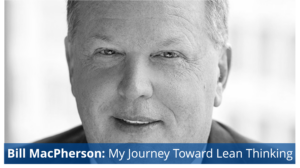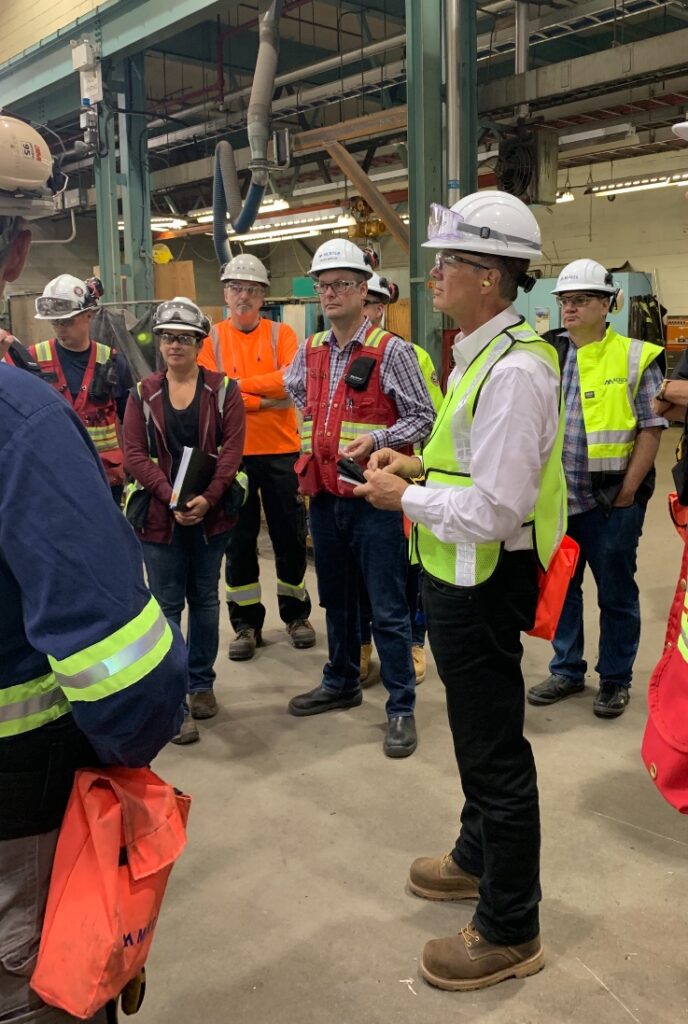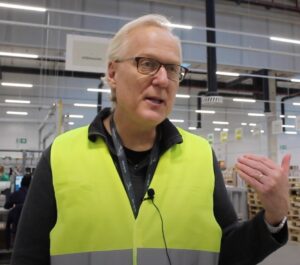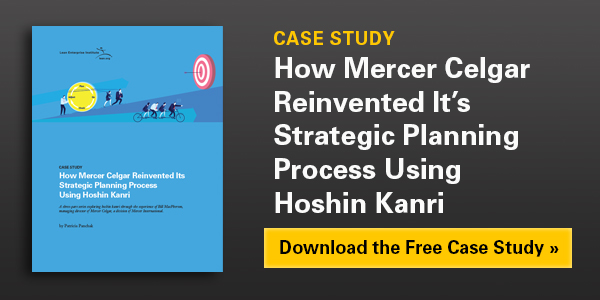When Mercer International’s Celgar Mill leadership team began exploring and using hoshin kanri for their strategic planning and execution, they used a go-it-alone approach, which Bill MacPherson, the mill’s managing director, says worked well. Still, he adds, “once we actually started working with seasoned practitioners, it made all the difference.”

Read part one, Breaking the Cycle of Ineffective Strategic Planning and Execution.
Read part three, Becoming — and Developing — More Effective Leaders.
The effort to adopt hoshin practices began with the Celgar team working through Getting the Right Things Done. “We read it together, and we went offsite and began trying to follow the model in the book,” MacPherson explains. “Even though it was rudimentary, it was a tremendous improvement.” The “roll up your sleeves and let’s see if we can get this done” experience also meant the team had better questions and was better prepared to learn from an experienced coach. Also, in keeping with the adage “perfection is the enemy of the good,” he notes: “Sometimes it’s just: get started with something good and then start improving it.”
Professional Coaching Catalyzes Companywide Interest
For the first foray into more formal learning, the Celgar team participated in the Lean Enterprise Institute’s Hoshin Kanri Remotely, a nine-session workshop where attendees learn and practice the strategy development and deployment approach. During the workshop, MacPherson notes, the team put together its 2021 hoshin. As critical, he says the team began to realize: “You’re trying to move a large, almost monolithic thing — a large organization. To get all that to move in one direction – or as much as you can – is a daunting task. That’s where hoshin kanri helps.”
As their learning and practice deepened during the workshop, MacPherson invited Mercer’s senior executive team into conversations with LEI Senior Lean Coach Mark Reich, who led the workshop the team had participated in. Though they’d involved David Gandossi, Mercer International’s CEO (in the photograph below), Adi Koppensteiner, Mercer International’s COO, and others from the start of their hoshin journey, their workshop experience helped them realize the need to keep senior executives in the loop. Initially, the goal was to help them “gain some insight and develop an understanding.” Then, as they developed the 2021 hoshin and started to understand the importance of process standardization across the company, the goal was to enable the senior leaders to participate and ask questions.

MacPherson also engaged others worldwide, including leaders of Mercer’s Stendal, Germany-based mill, Koppensteiner, Andre Listermann, and Bjorn Pecker. “We wanted not to push this but to give people insight into what we were learning and, perhaps, let them generate good questions,” MacPherson says. “And it’s done that: The word “hoshin” is now used across Mercer. Celgar is the practitioner of it, but there’s been an enormous amount of curiosity and interest and discussion as it’s evolving.”
Making a Difference to the Business
Though the benefits derived from hoshin kanri compound over time, the Celgar Mill already is seeing business results. “Celgar was a mill that was struggling with delivering business results for decades,” MacPherson admits, but “is now beginning to be seen differently.”
In conversations with other senior leaders, “it’s, wow, we’re seeing changes in the execution on the business side, the understanding of the business by the senior leadership team, and how engaged they are with the organization,” he adds. “So, yes, you can say it’s making a difference.”
Further, when MacPherson reviews the business results, he sees that the Celgar team is focusing on a couple of particular objectives that were hoshin-driven, where there are business results. Specifically, he credits the approach for the $2.7 million in cost savings achieved from continuous improvement projects completed in the first six months of the year. Also, he notes that the team implemented process improvements on 27 control loops, averaging a reduction in the standard deviation of 44%.
Anticipating the Next Hoshin Improvements
As they deepen their learning and extend their practice of hoshin, the Celgar leaders have a few areas they’ve identified where they can do better.
First, they’d like to extend hoshin planning participation to everyone working at the mill. With the earlier hoshin, MacPherson admits, they engaged through to the supervisor level before finalizing the plan, noting the rush at the end of the year precluded more people. This year, he adds, “We’re going to begin even earlier to give ourselves time to go all the way to the [front line], so we have time to take those inputs back up — and then we’ll have created an organizational plan, not a senior leadership plan.”
How Hoshin Kanri Improves Leadership Capabilities
Second, the leadership team plans to learn more about A3 problem-solving. MacPherson notes that until they participated in the LEI workshop, none of the Celgar leaders had had any formal exposure to the A3 methodology, so their use of the approach tended to be mechanical, a way to track progress on objectives. However, now that they’ve learned more about A3’s role in hoshin, they understand that A3 thinking and problem-solving are much more — that it’s about helping leaders learn how to ask great questions, to develop deep understanding of the work, and help the organization solve problems by going to the gemba. Ultimately, A3 thinking is a leadership and team-member capability development process, where the development takes place while doing the work.
Additionally, the Celgar team realizes that hoshin objectives are, essentially, “large, complex problems to solve, with a series of objectives and targets built-in,” explains MacPherson. “Typically, there’s quite a bit of analysis and understanding.” Through the hoshin work they’ve done, the team now realizes that they haven’t been going to the gemba to really understand and unravel the problem but rather to deploy solutions that they’d “already had in mind.”
Finally, with this new focus on engaging everyone in the business and improving A3 thinking and problem-solving, the leaders are transforming their approach to leadership. They’re working to change from being problem-solvers who simply cascade solutions to their teams, to becoming leaders who engage their team members — asking their thoughts and ideas about the problem and guiding them, working with them, and coaching them to come up with solutions.
As is typical of many companies that adopt hoshin to fix their ineffective strategy development and deployment process, Mercer’s Celgar team discovered how hoshin catalyzes improvement in many areas. So, as they progress through another year of hoshin planning and deepening their organization’s problem-solving capabilities, they’re already looking forward to their next learning opportunity: lean leadership coaching.
Learning More
Make this the year that you FINALLY succeed at executing your strategy. Join the Hoshin Kanri Remotely workshop, and learn a proven way to create and achieve your company’s annual objectives. Learn more and register.

Meet Senior Lean Coach Mark Reich, who stands ready to design an education and coaching program to help you adopt hoshin kanri and A3 problem-solving at your organization. In the tradition of LEI’s custom coaching approach, he’ll create a learning experience that will help you learn as you address a real and meaningful business objective. Schedule time today to talk with a lean coach.
Managing on Purpose with Hoshin Kanri
Learn how to develop strategy and build alignment.





